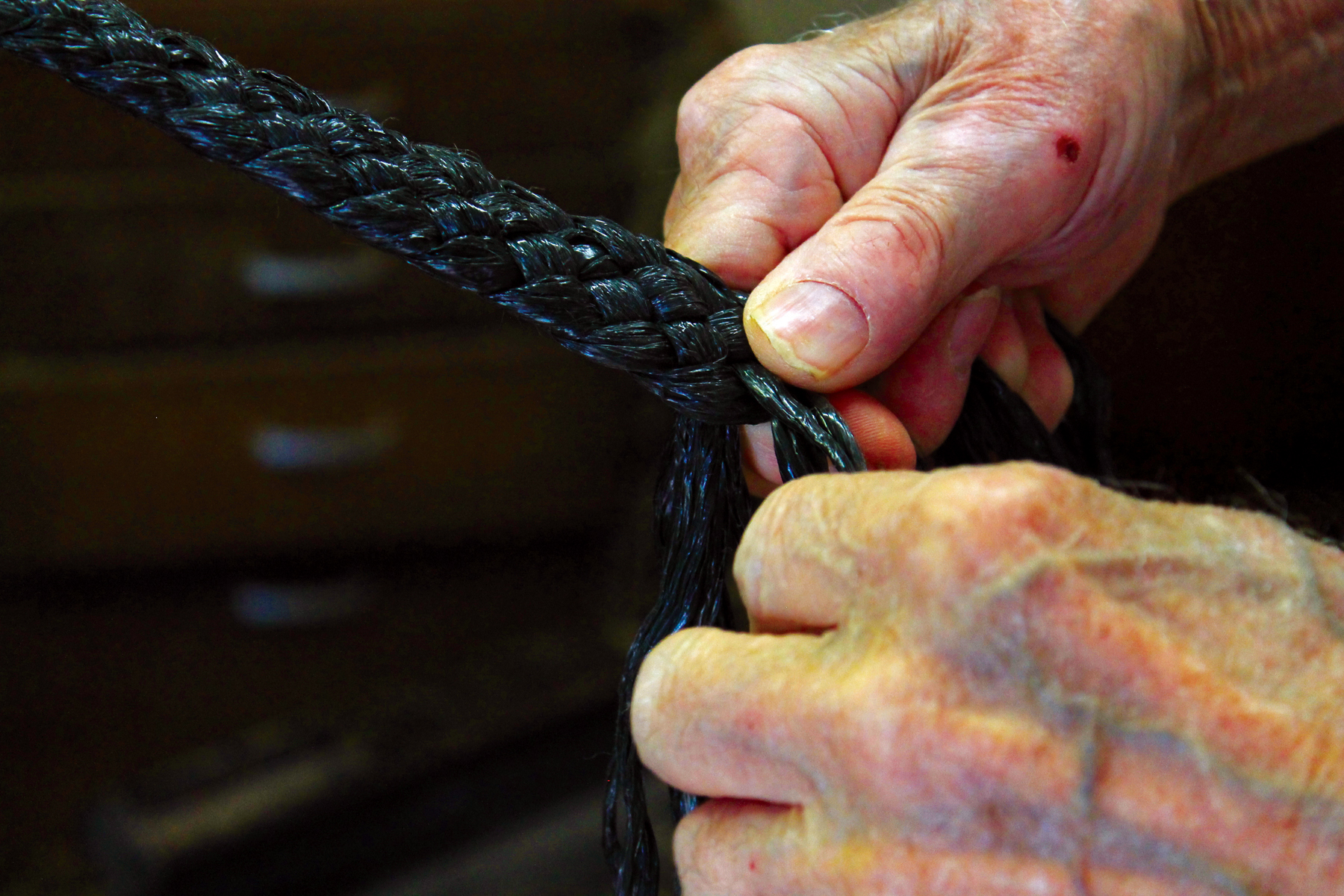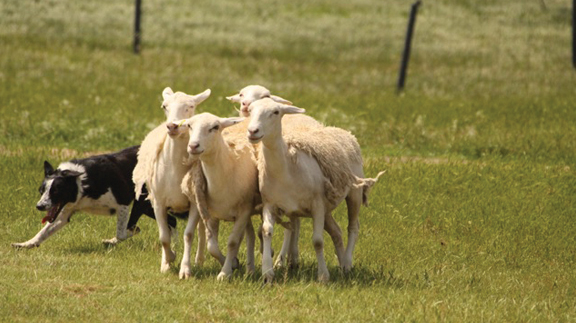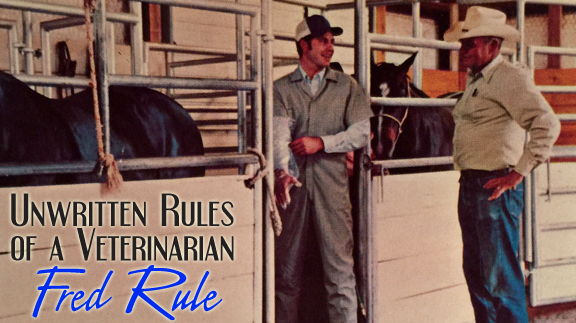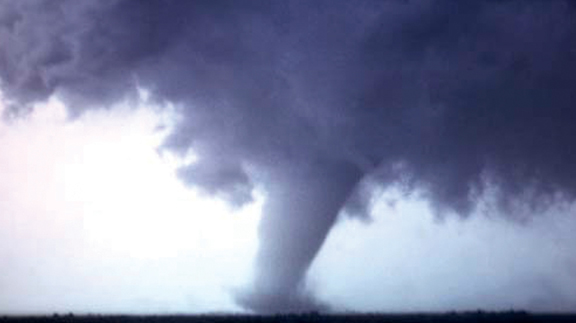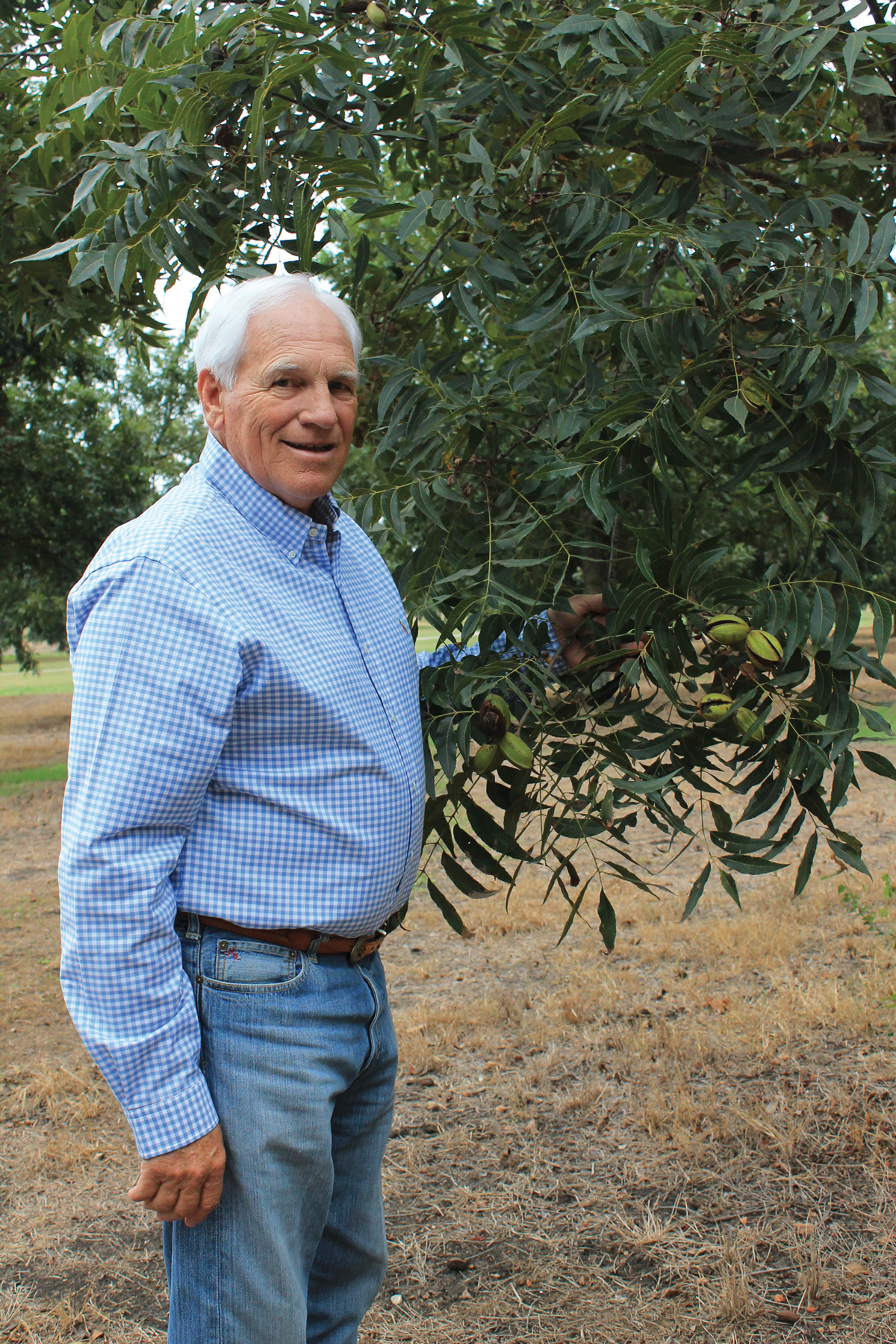Country Lifestyle
January 2018 Profile: Dick Carr
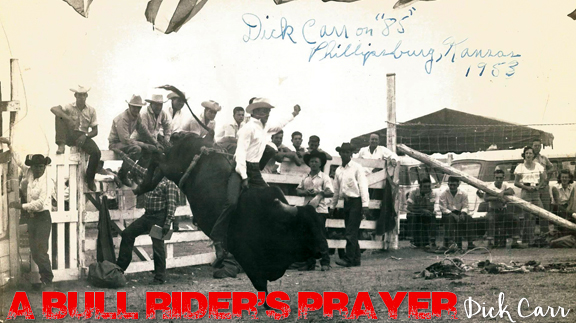
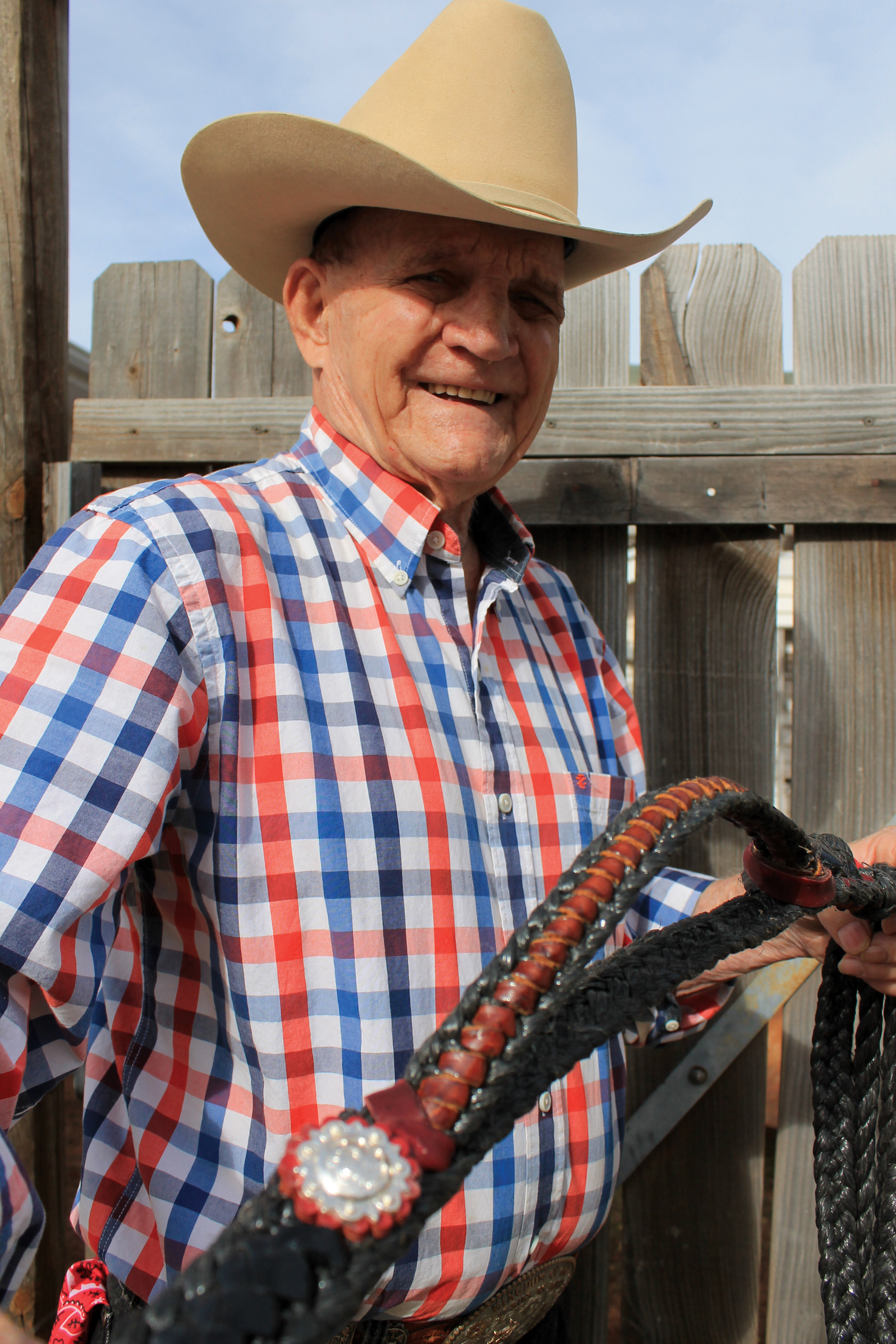
Carr’s first bull riding ropes sold for $10 apiece. Today, they start at $400. (Photo by Laci Jones)
A Bull Rider’s Player
By Laci Jones
At 84-years-old, former professional bull rider Dick Carr believes in the power of prayer, especially when making his renowned bull ropes. At his home in Elk City, Okla., he grabbed a bottle of oil, poured a few drops on his weathered fingertips and delicately held a bull rope.
He closed his eyes and said the prayer that he recites over each rope: “Your father God, I come to you in the name of Jesus, according to your word, anointing this rope with oil. I claim that [he] never hangs his hand in this rope or get this rope jerked out of his hand. I claim that he’s never injured in any way while riding a bull or going to or from a bull riding… Amen.”
The rope maker said he is a believer in the Lord, but has not always been faith-filled. Born just north of Canute, Okla., on Nov. 19, 1933, Carr described his family as “very poor.” His father built cotton gins, and added his parents “worked like dogs” to give their children the bare necessities. Raised on a farm in western Oklahoma, Carr and his sisters helped their parents by pulling cotton. They received one pair of shoes each year, but he said he was often barefoot by choice.
The barefoot boy did not always know he would become a professional bull rider. In fact, he recalled considering a career in the circus at seven years old.
“I was riding the school bus,” he began. “There was a train track there. I looked up and here comes this train, a circus train. It was blowing its whistle and it had all these paintings on it. As little as I was, I said, ‘That is my destiny. That is exciting. When I got home, I told mom, ‘I’m going to join the circus when I get big.’”
The dream of becoming a circus act did not last long, but his dream of performing was everlasting. Carr’s family relocated 10 miles west to Elk City, Okla., next door to the Beutler Brothers Rodeo Company.
“I got right in with their family from the time I was little,” Carr explained. “They have sort of adopted me. When we moved by Beutler Brothers, I saw all those bucking chutes, and I said, ‘That’s it. That is what I’m going to do.’”
Carr was a mischievous boy as he and his friends rode all the calves in the neighborhood, even when they were not given permission. While he did not enter rodeos until he was 16 years old, he started riding calves at the Elk City Rodeo.
“They kept putting me on bigger [calves] as I grew,” he chuckled. “There were people who taught me how to get on the big Brahmas, but I already knew how to get on. In order to be a bull rider, you’ve got to know how to get on. If you can’t get on them, there’s no need to [riding]. Then, you’ve got to learn how to get off.”
Learning how to mount and dismount properly is crucial for safety, but like many rodeo athletes, Carr was familiar with injuries. His first injury occurred at 14 years old when he was bucked off a bareback horse and broke his collarbone.

Dick Carr got his PRCA card in 1951, the number was later changed from 1235 to 166. (Photo courtesy of Dick Carr)
“You have got to be tough to be a cowboy,” he added.
He rode bareback and saddle broncs along with bulls, but he did not have the money to purchase a saddle.
“Saddles then were expensive—$100 was a lot of money,” Carr explained. “I had to give up bronc riding because when I got home, the whole world was spinning. I got hung up across the saddle, and the horse was spinning. I said, ‘God, if you’ll get me off here, I’ll promise I’ll never get on another bucking horse,’ and I never got on another saddle bronc.”
Carr was successful as a bareback bronc rider, but he preferred riding bulls. At 17 years old, the secretary at a rodeo in Waxahachie, Texas, told the young cowboy he needed to join the Professional Rodeo Cowboys Association to ride in that rodeo. When he started riding professionally, Carr said there were about 300 professional bull riders in the United States.
After graduating high school, the professional bull rider traveled with a fellow bull rider to rodeos in South Dakota, Nebraska, Colorado, Kansas, Texas, among other states, on the weekends. When he was not traveling to rodeos, Carr worked at the cotton gin but dreamed about competing at the Madison Square Garden Rodeo.
“That was the biggest rodeo,” he added. “That was just like going to the National Finals Rodeo now.”
Carr had a chance to compete with other professionals at the Madison Square Garden Rodeo in New York City when he was 18. The rodeo cowboy was at a rodeo in Pueblo, N.M., but he did not have any money. He drew an exceptional bull but was bucked off.
“It broke my heart,” Carr recalled. “I didn’t have the money to enter New York, and the fees closed the next day—$75 had to be paid before you were entered. The rodeo was still two or three weeks away, so I missed New York. The next year, I made sure that I had enough money to go.”
He continued to compete at the Madison Square Garden Rodeo as well as other major rodeos for the next several years, but his most memorable ride was at West Monroe, La., in 1954 on the bull that bucked off the world champion. The bull even bucked off Carr the year prior, but he received advice from an old cowboy.
“This old man who still rode bulls told me how to pull on a rope,” he recalled. “This bull had funny methods, and he said, ‘Put your hand right in the middle of his back and don’t pull it real tight.’”
The small bull bucked and hooked the riders. When Carr rode him in 1954, the bull jumped and spun to the left.
“He always gets you on the inside of the spin; he was always bad about that,” Carr added. “You would think because I put a rope over there that I was going to go farther over there. Everybody else pulled the rope trying to stay out of the inside of the spin, but I got in there with him.
“When he turned to the right, I looked to the left. When he turned to the left, I looked to the right. On the fourth jump, he looked to the left, I looked to the right and he got it. I rode him just so easy like it was nothing. When I stepped off, I undid my rope, jumped off and stepped right up on the fence, and he was still spinning.”
Carr was drafted into the U.S. Navy in 1956, serving in China and Australia. He returned a year later and set his sights on the arena. As all good things must come to an end, Carr gave up bull riding at the age of 25. However, he did return to the arena eight years later. The former professional bull rider picked up the art of making bull riding ropes at an early age, a skill he continues to use today.
Find the complete story in the January 2018 issue of Oklahoma Farm & Ranch.
Country Lifestyle
December 2017 Profile: John Jennings

By Laci Jones
Raised under the city lights of California, John Jennings is not your typical Californian. Born in El Centro, Calif., Jennings considered himself a “redneck,” spending many days hunting and fishing on the many California golf courses in Palm Springs, Calif.
“I would get kicked out of golf courses,” he said followed by a chuckle. “The security guards would run us off, and we would go to a different one.”
He was always “tinkering” with knives, guns and other items. Jennings recalled using circular saws as a child, saying it was “second nature.” At 17 years old, he dropped out of high school and began working full-time. Like his father, Jennings worked in construction.
“I was making $500 per week 30 years ago, which was pretty good money,” Jennings explained. “I moved out to my own apartment and just started doing my thing. Looking back, I wish I had gone to school because my son’s going to Oklahoma Baptist University, and he’s got so many opportunities.”
Jennings “bounced around” from job to job, never working at the same place for more than 18 months. His career took a backseat when he was diagnosed with Idiopathic thrombocytopenic purpura in his mid-20s. ITP is an auto-immune disease where the immune system sees blood platelets as foreign object.
“We were fixing to deer hunt out in the desert,” Jennings began. “I had these big ole bruises, and I didn’t think much of it.”
Jennings chalked the bruises up to clumsiness, but his wife suggested he visit the doctor to be sure. After his results came in, his doctor told him he needed to stay home, but Jennings was in denial.
“I felt 100 percent perfect. There’s nothing wrong with me,” he said. “I said, ‘No, I’m going deer hunting.’” They said, “Well, go ahead, but even a jar against a seatbelt could kill you.”
Jennings underwent many surgeries and chemotherapy treatments as well as took a daily concoction of pills to cure ITP. One chemotherapy treatment increased his appetite, causing his weight to rise to 250 pounds.
“I did this for like three years, and it finally just went away,” Jennings added. “By the grace of God, it went away.”
The southern California native said the experience changed his outlook on life. Ten years ago, Jennings and his family moved to Shawnee, Okla. He said the expense, traffic, regulations and the mounting doctor bills as well as his parents’ influenced his decision to relocate to the Sooner state.
“My parents wanted out of California 30 years ago, so they headed east on I-40 to look around,” he explained. “They originally were going to look in Arkansas, but they got stuck in a hail storm in Shawnee and stayed the night.”
Jennings said he lived in Shawnee, Okla., when he was eight years old, but moved back to California following the oil crash in the ‘80s. His parents later retired in Oklahoma.
“When I was kind of fed up with California too, my mom called and said, “There’s this really cute little house right across the street,” Jennings recalled. “It was a dump. My wife cried when she first saw it.”
Moving to Pottawatomie County allowed the California native to meet Bill Madole, a local bit and spur maker and neighbor of the Jennings family. Madole owned the land adjacent to Jennings, which overlooked the North Canadian River.
“[Madole] owns three corners of this river,” Jennings explained. “Once I found that out, I thought, “Man, I would like to hunt that.”
Jennings worked out a trade with the landowner for hunting privileges. The construction worker completed projects like fixing Madole’s roof or installing a new door. Jennings began watching Madole work and thought it would be “cool to try.”
Jennings was quickly discouraged once the talented blacksmith told him how much the equipment cost. After, he didn’t give spur making as a side-business another thought. Then things changed. Four years ago Madole was preparing to leave for the National Finals Rodeo where he had a booth.
“I said, ‘I’ll help you get ready for the NFR, and you show me how to make spurs,’” Jennings recalled. “He was sitting there, engraving while we were talking, and he said, ‘okay.’”
The apprentice was tasked with filing spur rowels, which he described as “monotonous” tasks. He continued to learn from the expert, copying his style of spur making.
“We do what is called ‘Texas-style spurs,’” Jennings explained. “The Texas-style is a bit more utilitarian than the Mexican or California-style spurs.”
The Mexican and California-style spurs are more ornate with more silverwork, and they have a larger rowel than the Texas-style, he added. The Texas-style is more subdued. Jennings said he did not experiment with other styles, contributing most of his influence from his teacher.
“I rely heavily on his style because, to me, that’s how it gets passed down,” he stated. “There’s a guy named Kevin Burns whose spurs are pretty expensive. He learned from a guy named Jerry Cates. If you look at a Burns spur, it looks a whole lot like Cates.”
Jennings said the same could be said of Billy Klapper, who learned from the “Godfather” of Texas-style spurs, Adolph Bayers.
“I remember I sold a couple pair to a guy in Stillwater, Okla., who was a trader,” he recalled. “He was carrying a pair of mine around a big spur show in Abilene, Texas. Another spur maker said, ‘Oh, you’ve got a pair of Madole spurs,’ and he said, ‘No, this is Jennings’ spurs, but he learned from Madole.’ This is how distinctive my buddy’s style is.”
He said the distinction of the spurs could be seen in the details. Many spur makers do not engrave in the steel, but Jennings and Madole make individual cuts in the steel to create a distinct design. Also, the area between the band and the shank is squared off, which requires more effort.
While he is inspired by Madole’s work, Jennings also has more resources available than his mentor had.
“I look all the time on the Internet, seeing what’s out there and getting ideas,” Jennings explained. “If [Madole] wanted to see spurs, he had to drive to Amarillo, Texas, to a show. I think it’s just easier for people to get started across the board nowadays.”
Jennings said he never thought he would pick up the art of spur making because his background did not include horsemanship. The spur maker sent a pair he was proud of to a friend, who took them to a horseman. The horseman complimented the spurs, and Jennings’ friend mentioned he does not ride horses. The horseman said, “Well, that’s kind of a fraud.”
“My take on it is the guy who builds NASCAR cars probably can’t drive them or a pilot does not work on the airplane that you’re flying across the country,” the spur maker explained. “A good horseman does not equate to being able to do silverwork and vice versa.”
Jennings said his first pair of spurs were “good” for a first pair, but overall, they are “okay.”
The spur maker has improved since then, stating a good set of spurs takes time and attention to detail. Lately, Jennings has been inspired by old-fashioned designs including the 100-year-old design, gal-leg spurs.
“The gal-leg spurs are a really old-fashioned patterned, but every guy has to draw his own,” he explained. “Every guy’s gal-leg spurs are a little bit different.”
On average, Jennings spends 20 to 100 hours on a pair of spurs. The process begins with design. His background in sculpting ceramics helped him become the spur maker he is today.
Jennings traces his new designs on paper, then copper before cutting it out. The design is traced on the steel, which is then cut with a bandsaw. Once the bands are cut, the spurs are placed in the forge until the metal is red-hot. They are then formed into the shape of a spur. Then the shank is welded to the band and filed to smooth out any indentions.
The design for the silver is planned, then cut with a small saw and soldered on the spur. Once the spur maker cleans the spur, it is ready for engraving.
“It’s like another well-known spur maker said, ‘You want to have a really nice, delicious cake,’” Jennings explained. “The metaphor is about having a real quality spur before you ever put silver or engraving on. The decoration is just that, the icing on the cake.”
Jennings said what differentiates his and Madole’s spurs from other spur makers is their spurs are sterling silver mounted while others use nickel silver. For a swan-design spur, Jennings uses 925 silver or pure silver, which is considered more malleable than other metals.
In the past four years, the spur maker has completed more than 50 projects ranging from buckles to spurs. While buckles take less time, his spurs earn Jennings more money. His spurs cost anywhere from $650 to $2,500. Jennings has also competed in spur shows, stating winning is what drives him forward.
“When I’m sitting here, thinking filing on all of these spurs sucks, I think about how I want to win,” the spur maker commented. “That’s why I do it. That’s what keeps me going.”
Jennings earned the first place prize at the Cowboy True Art Show in Wichita Falls, Texas, and plans to compete again next year.
The spur maker attributed his patience to listening to old outlaw country including Waylon Jennings and George Jones while working on projects. He is currently working on spurs featuring a horse head, which he has invested 20 hours in thus far.
Jennings still works in construction full-time. However, he said rainy days and other construction delays allow him ample time to devote to his craft.
Jennings still lives in Shawnee, Okla., with his wife, Candace, who also helps contribute to his side-business. Together, they have four children ranging from ages six to 26—Char, John, Kate and Ella.
When asked what advice he would give to a new spur maker, he referred back to the advice given by his mentor.
“[Madole] told me a while back, ‘Slow down, do a nice job, which we both know that you can do,’” he recalled. “Don’t be in such a hurry.”
To order, call 405-249-6920 or email [email protected].
This article originally appeared in the December 2017 issue of Oklahoma Farm & Ranch.
Country Lifestyle
November 2017 Profile: Scott Landgraf
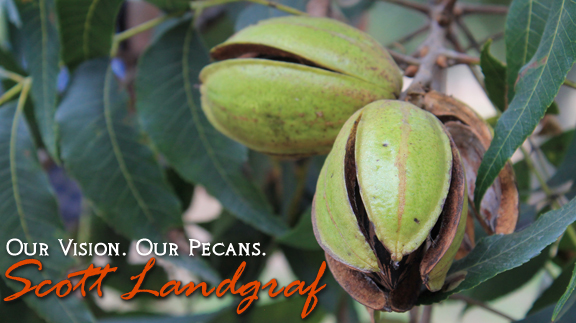
Our Vision. Our Pecans.
By Laci Jones
On a cloudy, late September morning in Madill, Okla., Scott Landgraf picked a pecan off the ground and pulled out a small pocket knife. The owner of Landgraf Farms began carving away the shell, leaving two pecan halves. Once he finished splitting the pecan, he looked up and said, “This is a lost art.”
Oklahoma produces an average of 20 million pecans each year, Landgraf explained. This year, Oklahoma is predicted to harvest 30 million pounds of pecans.
“The largest crop that’s been reported in history is 60 million from Oklahoma,” he added. “I don’t know how this crop is going to come out, but it may be more than 30 million this year. It’s really a pretty good crop.”
Born in 1948, Landgraf saw firsthand the advancements in pecan harvesting, sanitization and shipping. Growing up, his father Bill Landgraf harvested native pecan trees that grew along the creeks.
“My interest in pecans stemmed from the first real money I ever made by picking pecans up out of the water in the creek,” Landgraf recalled. “It was very hard work, but I look back on it as favorable memories.”
The father-son duo climbed many native pecan trees and used cane poles to flail the pecans. The pecans that landed on the bank were his dad’s, and Landgraf claimed the pecans that he could clean out of the creek, he added.
“My family saw pecans as an opportunistic crop,” Landgraf said of his parents. “It was not a crop per se. It was just something that enabled them to have extra things for what we think as today as just bare necessities.”
In the early to mid- ‘60s, Bill began seeing pecans as orchards. He cleared bottomland and started grafting the pecan trees to varieties available—Stuart and Mahan. Bill later began experimenting with different pecan varieties in the ‘70s. While some pecan varieties fared better than others, Bill had a successful harvest. His wife Leota took the first step in marketing Landgraf Farms by selling pecans out of their carport.
Meanwhile, Scott Landgraf attended Murray State College in Tishomingo, Okla., where he met his wife Janice. A year behind Landgraf in college, she followed the Madill, Okla., native to Oklahoma State University, where she received a bachelor’s degree in education. They married in 1971.
While pursuing a master’s degree in agronomy from OSU, Landgraf began working for the Noble Foundation. Landgraf obtained his master’s degree in 1973 and began his career spanning 30 years with the foundation now known as the Noble Research Institute. Landgraf first worked as a manager of their soil and forage testing laboratory. As time progressed, the manager became an agricultural consultant.

Landgraf Farms plant a variety of pecans on their farm in Madill, Okla., including the Pawnee variety. (Photo by Laci Jones)
“As time went on, they recognized my interest in pecans,” Landgraf explained. “I continued to do a lot of work in water and nutrition associated with pecan production and towards the end of my tenure with the Noble Foundation, I was their pecan specialist. My years at Noble have provided me an amazing education into the process of growing pecans.”
At 55 years old, the pecan specialist retired from the Noble Foundation to focus on the family farm. He started his pecan orchard in 1976, planting 250 pecan trees out of sight.
“I planted them back where nobody could see them because I didn’t know if it was going to work or not,” Landgraf laughed. “I was afraid of everyone seeing my failure.”
The planting was successful with only about three trees dying that season. Landgraf said the first season proved the pecan business takes labor and commitment. From planting to harvest, pecan production became a family endeavor.
“In fact, we had a baby at the time, and we set a playpen in the middle of planting trees,” Landgraf recalled. “We basically planted trees around the baby.”
That commitment was tested in June 1996 when a thunderstorm uprooted nearly every native pecan tree to the east of the farm. While orchards were also located on the west side of the farm, Landgraf said the storm demolished one of their main sources of income and involvement in pecans.
“It was a matter of just pushing them up in a pile and burning them,” he added. “There was no recovery.”
The setback resulted in a family meeting to discuss the future of Landgraf Farms.
“I remember very vividly setting the family around the table to say, “Hey, are we going to go ahead and rebuild this or are we going to just stay at this size?” he recalled.
It was a unanimous decision among the Landgraf family to rebuild the orchard. They cleaned up all the debris from the storm, drilled wells and installed irrigation lines. With a large tree spade, they moved half of the trees on the west side of the farm to the east.
Many people commented on the project, thinking the Landgraf’s were building a large barn.
“When I got ready to transplant the trees, I cut all side limbs off and painted the trunks white,” Landgraf explained. “When they looked up here, it did look like the start of a barn with just a pole sticking up.”
The project could be viewed from the Landgraf’s back window. His wife Janice said the trees looked like a cemetery with the trees resembling tombstones. She asked Landgraf if it will ever look like a pecan orchard, he recalled with a laugh.
Today, the pecan orchard no longer looks like a cemetery but like a pecan orchard, but each year takes the same commitment and hard labor as the first year. Each January and February, the Landgrafs plant 10 to 15 acres of new orchards, which entails installing main water lines, irrigation systems and well development.
Buds start to break by the first of April, and Landgraf applies zinc and nitrogen to the developing leaves.
“I might put on an insecticide, but I think that the zinc and nitrogen spray is just really important to the development and the health of the tree,” he added.
During the dormant season, he monitors for common diseases and pests that can be detrimental to the health and development of the pecan trees including pecan scab and pecan nut case bearer.
The shucks on the pecans start to split by the end of September. Because the pecans are not harvested until October and November, the pecans are vulnerable to freeze.
“There’s still that existing threat,” Landgraf explained. “As soon as the shuck splits, the shucks start to dry down and the nut is physiologically mature, we’ll start harvest.”
Landgraf harvests 160 acres on the farm, 100 acres on his father’s leased land and 500 acres of native pecan trees on leased land. He also currently has almost 100 acres of pecan trees planted that are not in production. The Landgrafs plant different varieties of pecans including Kanza, Caddo, Choctaw and Pawnee.
The Choctaw variety is their No. 1 big nut, Landgraf said. The desirables are big nuts, but they are disease-prone. Producers who choose to plant the Choctaw variety need to increase their “level of management” because the Choctaw variety requires plenty of water and nutrients to resist these diseases, he added.
The Kanza variety is a high quality pecan, but it is a small nut. The Caddo variety is similar to the Kanza variety in size, but it is more susceptible to diseases like scab. It is a high-quality nut and the most consistent yielder.
Landgraf found consumers will not purchase the small pecan varieties like Kanza and Caddo in the shell because it is smaller than other varieties. However, consumers prefer the smaller nuts that are high-quality when the shells are removed.
“In all of agriculture, I think we have to conform our production practices to meet the demand of the consumer,” Landgraf explained. “In our retail shop, we certainly abide by that rule and cater to them.”
The Pawnee variety matures first, and the Landgrafs begin harvesting this variety by mid-October. The nuts are taken to the shop where they are cleaned, sanitized and dried.
“It is kind of an arrangement with my wife and me that I get them to the shop, and she takes them and sells them,” he added.
His wife Janice uses social media along with drive-by traffic to sell their entire crop in the farm’s retail shop. The retail shop is open November and December each year, selling a variety of products including chocolate covered pecans and pecan oil. As soon as all sales are completed, Landgraf begins fertilizing and cleaning up any brush left over from harvest.
With more than 30 years of experience in pecan production, Landgraf said there are three keys to have a successful pecan orchard—water, micro-organisms and nutrition. Making sure the pecan trees have an adequate supply of water is the most important key. Landgraf Farms implemented an irrigation system to combat the common Oklahoma drought.
“Along with that, I make sure that I’ve got adequate water supply and all my irrigation comes from wells,” he added. “I’ve been blessed with a major aquifer under the farm that I was not aware of. It’s just a real blessing.”
The second and third keys to encouraging healthy pecans are proper nutrition and micro-organisms. The Landgrafs apply pesticides to overcome threatening pests. It is imperative for producers to understand the life cycles of insects and diseases to properly manage the orchard.
“I only use pesticides when I have to have them,” he added. “I’m not saying I’m against use of pesticides. It’s just I use them sparingly, and my greatest friends are the beneficial insects and all the micro-life in the soil.”
Landgraf said technology made a positive impact on this growing industry.
“It went from using a cane pole to get them out of the tree to not knowing where you go to buy a cane pole,” he added. “It’s been in my lifetime, and we take it for granted.”
The pecan shelling plants had large structures with different devices when Landgraf was young. He said there was a divide in the industry from the growers, the shellers and the sellers. Landgraf’s father approached Basil Savage of Savage Equipment after attending a pecan shaker demonstration in Madill, Okla.
He convinced Savage to construct the first pecan shaker in his machine shop in Ardmore, Okla. Savage built and sold him that pecan shaker to use on the large native trees at the farm. The machine was not big enough to shake the trees well, so they had to shake them several times.
“I mean it was cool to use a tractor to get those nuts out instead of having to crawl around like a squirrel,” Landgraf recalled. “That process continued on. I can harvest the 160 acres on this place in less than a week with myself and a couple hands. It’s just phenomenal.”
As for the future of Landgraf Farms, he said he hopes to continue the vision of expansion with his family. He and his wife Janice have three sons—Jeff, Wes and Justin, and four granddaughters.
The retail shop is located at 18814 Highway 70, Madill, OK 73446. For addition information on Landgraf Farms, visit www.LandgrafFarms.com.
This article originally appeared in the November 2017 issue of Oklahoma Farm & Ranch.
Country Lifestyle
Western Housewives – September 2024

Fall is in the air and with it the impending doom that is another school year. For me, a homeschooling mom of three, it is not quite as dramatic as sending them to school each day, but the pain of realizing they are another grade older is still there.
This year, it is hitting me especially hard with my eldest child and only girl. Last year, she was an inquisitive first grader who struggled with certain letter sounds, and tally marks and, only wanting to go outside to practice running barrels. This year she is a confident second grader who can read full sentences, knows how to tell time and, still only wants to go outside to practice running barrels. This is the goal of schooling, of course, to make sure they are learning a little bit each day but, for some reason, it still stings.
Maybe it is the fact that just the other day she was a tiny baby in a pink onesie who was screaming her lungs out at Cheyenne, Wyo., every time an airplane flew over our living quarters trailer. I also think it was just yesterday that she was just a toddler running around the arena grounds in her cherry swimsuit playing in buckets of water. It was at those times she had me fooled into thinking that she would be that little forever and that she would always need me there to comfort and console her as she rejected my every “shhhhh” and “let’s have a juice box!”
The reality now is that she barely needs me at all anymore. She can catch her own horses, do her own hair, and make her own friends. Heck, I think she even makes better tortillas than me. How did this happen? Can someone please explain the phenomenon that is time?
The cold hard truth of all this is that I have been raising her to be this very thing from the moment she was born. I wanted her to be braver and stronger than me. I wanted her to love herself fiercely so she could love others fiercely as well. I wanted her to know the comfort of home so she could feel the confidence to leave it someday. I raised her to be a wonderful and independent woman and now I hate myself a little for it. Dramatic? Probably so but, couldn’t she be a little more needy? Is that too much for a cowgirl mother to ask?
While I am faced with the reality of a growing young lady it has caused me to look deep inside myself and consider the young lady I want to be myself. “Young” always being a relative term of course. What kind of role model do I want to be for this little girl who looks up to me more than I could have ever imagined?
Of course, I wanted to be kinder. I want to be considerate of others’ feelings. Generous. God fearing above all. All these things are attainable with a little devotion to one’s Bible and something we as parents do already.
But I kept thinking. What is the one thing I need her to realize to be able to survive in this world? And I realized that was just it. She needed to forget the world.
The world will tell little girls that they need to conform. That they need to be pretty and to wear designer labels. That They need to be perfect wives, mothers, and the ultimate career women. And then it will turn right around and tell them that it is impossible. That they are depressed, and that maybe if they got a new car, home, or family it would be better for them. The world continuously tells them that they are not enough and that maybe a little more self-care will rectify that problem. One more facial and they will be a new woman.
I may be considered an old haggard woman for this and, I guess I kind of am but, I don’t remember the last facial I had. I love being with my family, and I drive a 1990s Lexus. I for one don’t want my little girl to ever hear any part of what the world is telling her. I want her to run as far from it as she can and be the innocent, tender-hearted but, strong woman God has called her to be. I want her to ride horses and be content working in the garden first thing in the morning. I want her to acknowledge the fact that people who work in agriculture are a special breed and should be admired and emulated. I want her to like her coffee black, except on her birthday where sugar and cream is totally acceptable. I want her to get her hands dirty but, know how to wash them with lavender soap. I want her to be different than the rest of the world.
Women are in a tough spot in the world these days because we have put ourselves there. We need to step back and remember the power there is in just being ourselves. Somewhere along the way We have forgotten that we can be quiet and still be a force to be reckoned with. We have forgotten that we can stay home and raise babies and still change the world.
This is a tough message to send to a seven-year-old cowgirl, but you know me, just out here doing the Lord’s work. All jokes aside, I know I could never accurately describe all this to my daughter. So, I will have to show her instead. It will be a hard and at times a daunting task. Some days I will wake up and don’t know if I am capable at all. I am a mother who fails often. I lose my temper, I give up, and I cry. Sometimes I give them ice cream for supper and wear white after Labor Day. I am a human, and it shows. But, maybe that’s what she needs to see? Maybe being vulnerable and failing but picking myself up anyways is the lesson that little girls need to be taught? Maybe standing beside her dad instead of in front of or behind is exactly where she needs to see me. Maybe helping her along the way instead of constantly pointing my finger is the friend she really needs.
There are a lot of “maybes” in motherhood and in life. I don’t know if there is always supposed to be an answer either but, I do know that there is value in being a mama to a little cowgirl. She teaches me to keep going, to do better, and to up my tortilla game or I will be out of the job.
This article originally appeared in the September 2024 issue of Oklahoma Farm & Ranch.
-

 Attractions8 years ago
Attractions8 years ago48 Hours in Atoka Remembered
-

 Country Lifestyle6 months ago
Country Lifestyle6 months agoJuly 2017 Profile: J.W. Hart
-

 Country Lifestyle9 years ago
Country Lifestyle9 years agoThe House a Treasure Built
-

 Country Lifestyle3 years ago
Country Lifestyle3 years agoThe Two Sides of Colten Jesse
-

 Outdoors7 years ago
Outdoors7 years agoGrazing Oklahoma: Honey Locust
-

 Outdoors5 years ago
Outdoors5 years agoPecan Production Information: Online Resources for Growers
-

 Equine7 years ago
Equine7 years agoUmbilical Hernia
-

 Farm & Ranch6 years ago
Farm & Ranch6 years agoHackberry (Celtis spp.)

